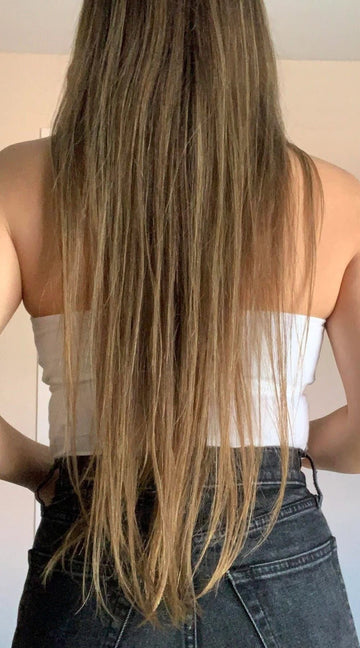The truth about extensions and how to protect your hair
Introduction
If you’ve ever dreamed of longer, fuller hair, it’s tempting to think extensions are the only way. But the truth? You don’t actually need extensions to have gorgeous, healthy, head-turning hair.
Most women don’t have “bad hair”- they have stressed hair. Years of heat, color, and product buildup can make your ends weak and your length stall. That’s why at Twice As Good Hair, we’re all about rebuilding your strands from the inside out- strengthening, hydrating, and encouraging real growth that lasts.
Still, we know there are moments when you want that instant boost- maybe for an event, or while you’re in the middle of your healthy hair journey. If that’s the case, here’s how to choose the least damaging types of extensions and protect the progress you’re making toward naturally long, healthy hair.
Why Extensions Can Be Risky for Hair Growth
Extensions are beautiful- but they’re not always kind. When they’re installed without care, they can cause tension, breakage, and even slow your natural growth.
Here’s what typically causes damage:
-
Tension on the scalp – Extensions that are too tight or too heavy pull on your natural hair, stressing the follicles.
-
Adhesives and heat – Glues, tapes, or bonds can dry out your strands and cause shedding at the roots.
-
Improper removal – Many women lose length during removal, not installation, when stylists rush or use harsh solvents.
-
Neglecting natural hair care – When extensions are in, it’s easy to forget your real hair still needs nourishment and hydration.
The goal is to grow stronger, not just longer- and that means keeping your natural hair as healthy as possible underneath.
If You Must Wear Extensions — Choose the Gentlest Types
While we’ll always recommend focusing on growing your hair out naturally, these are the least damaging methods when applied by a certified, educated stylist.
1. Halo or Wire-Weft Extensions — Zero Tension, Zero Glue
Best for: Fragile or recovering hair
Why they’re gentle: They sit on your head with an invisible wire (like a headband) instead of attaching to your hair. That means no pulling, no glue, and no breakage.
Ideal for: Anyone growing their hair out who wants occasional fullness without slowing progress.
2. Hand-Tied Wefts — Low-Tension and Customizable
Best for: Medium to thick hair that’s already healthy
Why they’re gentle: They’re sewn into small sections instead of glued, which distributes weight evenly.
Bonus: They move naturally and blend beautifully, but they must be installed by a certified stylist who understands scalp tension and safe removal.
3. Micro-Ring (I-Tip) Extensions — No Heat or Adhesive
Best for: Strong, medium-to-thick strands
Why they’re gentle: Each strand is attached with a small silicone-lined bead — no heat, glue, or tape.
Caution: The bead size and placement matter. When applied too tightly, they can cause shedding. (This is why your stylist’s skill level matters more than anything.)
Why Your Stylist’s Education Matters More Than the Method
Extensions don’t cause damage- inexperience does.
A highly trained stylist doesn’t just apply extensions; they assess your scalp health, map out tension zones, and choose a method that protects your natural growth.
Here’s what sets an educated stylist apart:
-
Certified in multiple extension systems (not a one-day crash course)
-
Understands scalp health and follicle tension
-
Knows when to say “not yet” if your hair isn’t ready
-
Uses premium, ethically sourced human hair only
-
Prioritizes safe removal and regular maintenance
-
Encourages healthy growth habits under your extensions
A stylist who truly knows hair health will never jeopardize your natural growth for temporary results.
How to Support Your Natural Growth (With or Without Extensions)
Even if you’re wearing extensions short-term, your real hair deserves daily love. The stronger your natural hair is, the better your extensions will look and feel.
Here’s how to support natural growth from root to ends:
-
Use a moisturizing treatment 2x per week to hydrate, seal split ends, and promote strength.
- Our customers rave about the The Deep Hydration Treatment which does just that
-
Focus on consistent scalp care — Massage in a nourishing spray to boost circulation and stimulate growth naturally.
- Try our Nourishing Hair Growth Spray - a lightweight blend of organic jojoba, avocado, and argan oils that nourish your scalp
- Try our Nourishing Hair Growth Spray - a lightweight blend of organic jojoba, avocado, and argan oils that nourish your scalp
→ For a complete system, our Deluxe Hair Growth Kit combines everything you need to grow stronger, longer hair from the inside out.
- Sleep smart: Use a silk pillowcase or tie your hair in a loose braid to reduce friction.
- Stay consistent: True results come from routine. Consistency is the secret ingredient behind every “my hair finally grew” story.
The Real Takeaway
Extensions can enhance your look- but your own hair deserves to shine.
If your goal is long, healthy, effortless hair, focus on nourishing your natural strands first. Build strength, hydrate deeply, and restore your ends before adding any extra weight or tension.
And if you absolutely need extensions?
Choose a certified stylist who prioritizes hair health, uses gentle techniques, and guides you through proper aftercare.
Because when you protect your natural hair and invest in real growth- you’ll soon find you don’t need extensions to feel confident, radiant, and twice as good.






